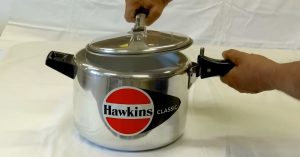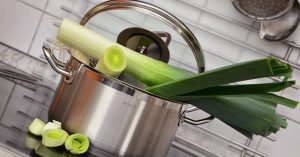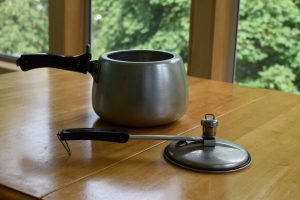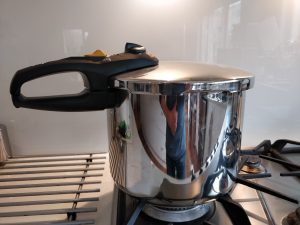Do you know “how to clean aluminum pressure cooker?” Cleaning up pressure cookers can sometimes be a challenging task, especially when faced with stubborn stains, burnt food, and those pesky leftovers clinging to the walls.
But fear not! I’m here to lend you a helping hand in tackling the aftermath of your culinary adventures. When I cook my favorite recipes, I understand the struggle of dealing with tough stains and stuck-on food. That’s why I’ve mastered the art of cleaning up pots and pans, including my trusty pressure cooker.
With a little guidance, you’ll be able to restore your pressure cooker to its pristine condition, thanking your kitchen appliance for its unwavering support as you whip up delicious meals. Let’s dive in and conquer those cleaning challenges together!
How To Clean Aluminum Pressure Cooker: To clean an aluminum pressure cooker: cool down, remove parts, rinse, use mild detergent, scrub gently, rinse thoroughly, dry, reassemble, and store properly.
Quick Navigation
How To Clean Aluminum Pressure Cooker?
Cleaning a pressure cooker can be a straightforward process, but when there’s burnt food involved, it requires some extra effort. Here is a detailed guide to help you clean your pressure cooker effectively:
- Fill the pressure cooker: Start by filling the pressure cooker with warm water and adding a few drops of dishwashing liquid. Ensure that the water level is enough to cover the burnt areas.
- Soak the pressure cooker: Allow the pressure cooker to soak for about 1-2 hours. This will help loosen the burnt food and make it easier to remove.
- Wash the cooker: After the soaking period, use a cloth or sponge soaked in dishwashing liquid to scrub the inside of the pressure cooker.
Pay special attention to the burnt areas and any stubborn stains. Apply gentle pressure while scrubbing to avoid damaging the cooker’s surface.
- Rinse thoroughly: Once you have thoroughly scrubbed the pressure cooker, rinse it under the tap with hot water. This will remove any remaining soap residue and food particles.
- Dry the pressure cooker: After rinsing, remove the pressure cooker from the sink and dry it using a clean dishcloth. Make sure to dry both the inside and outside surfaces to prevent water stains or spots.
For Aluminum Pressure Cookers:
White vinegar solution:
To remove stubborn grime or stains on an aluminum pressure cooker, you can create a solution of water and white vinegar. Fill the cooker with the solution and let it soak overnight. The vinegar will help loosen the grime for easier cleaning.
Rinse off the vinegar:
After soaking, thoroughly rinse the pressure cooker with water to remove any traces of vinegar. It’s important to rinse it well to prevent any potential damage to the aluminum material.
Test vinegar on a small area:
If you’re unsure about using vinegar on your pressure cooker, perform a patch test on a small, inconspicuous area. This will help ensure that the vinegar does not cause any adverse reactions or stains on the aluminum.
Baking soda solution:
As an alternative to vinegar, you can create a solution of water and baking soda. Apply this solution to the stubborn areas and let it sit overnight. Then, scrub gently with a sponge or cloth to remove the grime.
By following these detailed steps, you can effectively clean your pressure cooker and restore it to its original shine, ensuring its longevity and optimal performance.
Cleaning the Lid and Accessories
Properly cleaning the lid and accessories of your pressure cooker is crucial to ensure cleanliness and functionality. Here is a detailed guide on how to clean them effectively:
- Start by removing the lid and any removable accessories, such as the gasket or pressure regulator, if applicable. Follow the manufacturer’s instructions for safe removal.
- Rinse the lid and accessories with warm water to remove any loose debris or food particles. Use your hands or a gentle stream of water to thoroughly rinse all surfaces.
- If you notice stubborn stains or food residue, prepare a solution of mild dishwashing detergent and warm water. Dip a non-abrasive sponge or cloth into the soapy solution.
- Gently scrub the lid and accessories with the sponge or cloth, paying extra attention to areas with stains or residue. Avoid using harsh abrasives that could scratch or damage the surfaces.
- For the pressure release valve, inspect it closely to ensure it is clean and free from any blockages. Use a small brush or a pipe cleaner to carefully clean any debris that may be lodged in the valve.
- Once you have thoroughly cleaned the lid and accessories, rinse them again with clean water to remove any remaining detergent residue.
- After rinsing, use a clean, dry cloth to completely dry the lid and accessories. Make sure to remove any moisture to prevent the growth of bacteria or rusting.
- When reassembling the accessories onto the pressure cooker, ensure they are properly aligned and securely fitted. This will help maintain a proper seal during cooking.
- Finally, store the pressure cooker lid and accessories in a clean and dry place, away from direct sunlight. This will help prevent any potential damage or deterioration.
By following these detailed steps, you can effectively clean the lid and accessories of your pressure cooker, ensuring hygiene, and prolonging their lifespan for safe and efficient cooking experiences.
Disassembly (if applicable)
To begin disassembly, start by removing the gasket, which is the rubber sealing ring, from the lid of the pressure cooker. Gently grip the gasket and pull it off, being careful not to stretch or damage it. Set the gasket aside for cleaning separately.
If your pressure cooker has any other removable parts, such as handles or pressure regulators, check the manufacturer’s instructions for guidance on how to safely detach them.
These additional parts may vary depending on the specific model and design of your pressure cooker. Follow the recommended steps provided by the manufacturer to ensure proper removal without causing any harm to the pressure cooker or its components.
It is crucial to strictly adhere to the manufacturer’s instructions for disassembly. These instructions are designed specifically for your pressure cooker model and will provide you with the necessary guidance to safely remove any applicable components.
Following the manufacturer’s guidelines will help prevent any accidental damage to the pressure cooker and ensure a smooth and successful disassembly process.
By carefully removing the gasket and any other detachable parts according to the manufacturer’s instructions, you can prepare your pressure cooker for thorough cleaning and maintenance.
Drying and Reassembling
After cleaning the pressure cooker and lid, take a clean and dry cloth. Thoroughly wipe down both the interior and exterior surfaces of the pressure cooker, making sure to remove any remaining moisture. Pay extra attention to areas that tend to retain water, such as corners and crevices.
Before moving on to reassembling, ensure that all parts of the pressure cooker, including the lid and any removable accessories, are completely dry. Moisture left behind can lead to rust or other issues, so take the time to dry each component thoroughly.
If your pressure cooker has removable accessories like handles or pressure regulators, now is the time to reattach them. Carefully align each accessory with the designated attachment points, following the manufacturer’s instructions. Take care to fasten them securely, ensuring they are tightly fitted.
Next, it’s time to place the gasket, which is the rubber sealing ring, back onto the lid. Make sure the gasket fits snugly and is properly seated in its groove. Take a moment to inspect the gasket for any signs of damage or wear.
If you notice any issues, it’s best to replace the gasket to maintain a proper and airtight seal during pressure cooking.
By following these detailed steps, you can ensure that your pressure cooker is thoroughly dried and reassembled correctly. This will enable you to use the pressure cooker safely and efficiently for your cooking needs.
Safety Precautions
When dealing with a pressure cooker, it’s important to prioritize safety. Here are some key safety precautions to keep in mind:
- Allow the pressure cooker to cool down: Before attempting to clean or disassemble the pressure cooker, ensure that it has cooled down completely. This will help prevent burns or injuries from hot surfaces or steam.
- Release pressure properly: Before opening the pressure cooker, always ensure that the pressure has been released completely. Follow the manufacturer’s instructions for the appropriate method of pressure release. Failure to do so can result in sudden steam release, leading to potential burns.
- Disconnect from the power source: If your pressure cooker is electric, make sure to disconnect it from the power source before cleaning or handling it. This eliminates the risk of electric shock or accidental activation of the cooker.
- Read the manual: Familiarize yourself with the manufacturer’s instructions and safety guidelines provided in the manual or guidebook. These instructions will outline specific precautions and procedures that are unique to your pressure cooker model.
- Use suitable cleaning agents: When cleaning your pressure cooker, use mild dishwashing detergents or cleaners recommended by the manufacturer. Avoid harsh chemicals or abrasives that can damage the cooker’s surfaces or compromise its functionality.
- Handle with care: Always handle the pressure cooker with caution, especially when disassembling or reassembling. Avoid rough handling or dropping the cooker, as this can cause damage or create safety hazards.
- Store properly: When not in use, store the pressure cooker in a safe and secure location, away from children’s reach. Ensure that it is stored in a stable position to prevent accidents.
By following these safety precautions, you can minimize the risk of accidents and ensure a safe experience while using and cleaning your pressure cooker.
FAQs:
Q:1 How can I restore an aluminum pressure canner?
Wash the pressure cooker and lid with warm, soapy water. Fill the pot mostly full with warm water and dissolve 2 tablespoons of cream of tartar. Boil the water over medium-high heat.
Q:2 What is the best way to remove stains from an aluminum cooker?
Boil the water in the kadhai for 5 minutes. As the water boils, you will notice the dirt loosening. Drain the water and then use a mixture of baking soda and detergent powder to scrub the kadhai. Finally, rinse the utensil with warm water to ensure it is clean and ready to use.
Q:3 Is it safe to clean my pressure cooker with vinegar?
For regular maintenance, you can clean the inner pot by adding 1 cup of white vinegar to the bottom. Let it sit for 5 minutes, then empty the vinegar and rinse thoroughly.
Q:4 How do I remove black stains from aluminum vessels?
To remove discoloration from aluminum utensils, create a solution by boiling a mixture of 2 to 3 tablespoons of cream of tartar, lemon juice, or vinegar per quart of water. Let the utensil boil in the solution for 5 to 10 minutes. Then, lightly scrub using a soap-filled scouring pad.
Q:5 How can I bring aluminum back to its original shine?
In a bucket, combine 1 tablespoon of white vinegar with 2 cups of warm water. Adjust the ratio accordingly for larger amounts. Dip a cloth or non-abrasive pad into the vinegar-water mixture and use it to gently clean the aluminum surface.
Conclusion:
In conclusion, maintaining a clean aluminum pressure cooker is essential for optimal cooking performance and hygiene. By following the recommended cleaning steps, including disassembly if applicable, washing with warm soapy water, and ensuring thorough drying, you can keep your pressure cooker in top condition.
Additionally, using solutions like white vinegar or baking soda can help remove stubborn stains and grime from aluminum surfaces. It’s important to follow the manufacturer’s instructions and test any cleaning solutions in small areas before applying them widely.
Regular cleaning and proper maintenance will ensure that your aluminum pressure cooker continues to serve you well, providing safe and efficient cooking for many delicious meals to come.
We hope you will be well of how to clean aluminum pressure cookers, after reading this comprehensive article. If you have any questions, feel free to comment below!




